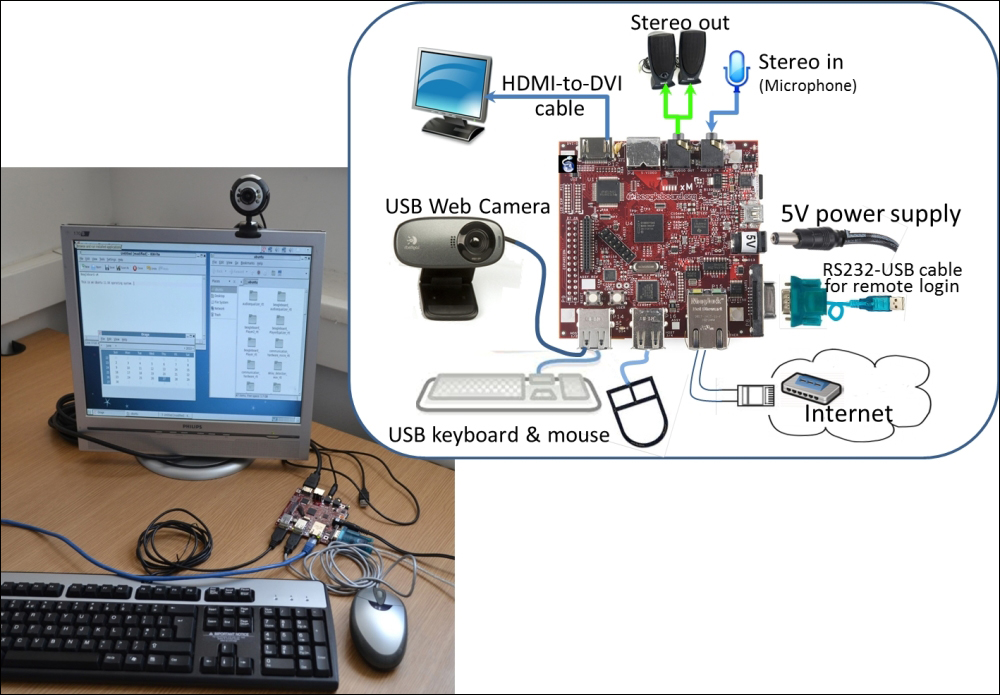BeagleBoard-xM
BeagleBoard, the brainchild of a small group of Texas Instruments (TI) engineers and volunteers, is a pocket-sized, low-cost, fan-less, single-board computer containing TI Open Multimedia Application Platform 3 (OMAP3) System on a chip (SoC) processor, which integrates a 1 GHz ARM core and a TI's Digital Signal Processor (DSP) together. Since many consumer electronics devices nowadays run some form of embedded Linux-based environment and usually are on an ARM-based platform, the BeagleBoard was proposed as an inexpensive development kit for hobbyists, academics, and professionals for high-performance, ARM-based embedded system learning and evaluation. As an open hardware embedded computer with open source software development in mind, the BeagleBoard was created for audio, video, and digital signal processing with the purpose of meeting the demands of those who want to get involved with embedded system development and build their own embedded devices or solutions.
Furthermore, by utilizing standard interfaces, the BeagleBoard comes with all of the expandability of today's desktop machines. The developers can easily bring their own peripherals and turn the pocket-sized BeagleBoard into a single-board computer with many additional features.
The following figure shows the PCB layout and major components of the latest xM version of the BeagleBoard. The BeagleBoard-xM (referred to as BeagleBoard in this book unless specified otherwise) is an 8.25 x 8.25cm (3.25" x 3.25") circuit board that includes the following components:

CPU: TI's DM3730 processor, which houses a 1 GHz ARM Cortex-A8 superscalar core and a TI's C64x+ DSP core. The power of the 32-bit ARM and C64+ DSP, plus a large amount of onboard DDR RAM arm the BeagleBoard with the capacity to deal with computational intensive tasks, such as audio and video processing.
Memory: 512 MB MDDR SDRAM working 166MHz. The processor and the 512 MB RAM comes in a .44 mm (Package on Package) POP package, where the memory is mounted on top of the processor.
microSD card slot: being provided as a means for the main nonvolatile memory. The SD cards are where we install our operating system and will act as a hard disk. The BeagleBoard is shipped with a 4GB microSD card containing factory-validated software (actually, an Angstrom distribution of embedded Linux tailored for BeagleBoard). Of course, this storage can be easily expanded by using, for example, an USB portable hard drive.
USB2.0 On-The-Go (OTG) mini port: This port can be used as a communication link to a host PC and the power source deriving power from the PC over the USB cable.
4-port USB-2.0 hub: These four USB Type A connectors with full LS/FS/HS support. Each port can provide power
on/offcontrol and up to 500 mA as long as the input DC to the BeagleBoard is at least 3 A.RS232 port: A single RS232 port via UART3 of DM3730 processor is provided by a DB9 connector on BeagleBoard-xM. A USB-to-serial cable can be plugged directly into the DB9 connector. By default, when the BeagleBoard boots, system information will be sent to the RS232 port and you can log in to the BeagleBoard through it.
10/100 M Ethernet: The Ethernet port features auto-MDIX, which works for both crossover cable and straight-through cable.
Stereo audio output and input: BeagleBoard has a hardware accelerated audio encoding and decoding (CODEC) chip and provides stereo in and out ports via two 3.5 mm jacks to support external audio devices, such as headphones, powered speakers, and microphones (either stereo or mono).
Video interfaces: It includes S-video and Digital Visual Interface (DVI)-D output, LCD port, a Camera port.
Joint Test Action Group (JTAG) connector: reset button, a user button, and many developer-friendly expansion connectors. The user button can be used as an application button.
To get going, we need to power the BeagleBoard by either the USB OTG mini port, which just provides current of up to 500 mA to run the board alone, or a 5V power source to run with external peripherals. The BeagleBoard boots from the microSD card once the power is on. Various alternative software images are available on the BeagleBoard website, so we can replace the factory default images and have the BeagleBoard run with many other popular embedded operating systems (like Andria and Windows CE). The off-the-shelf expansion via standard interfaces on the BeagleBoard allows developers to choose various components and operating systems they prefer to build their own embedded solutions or a desktop-like system as shown below:



























































